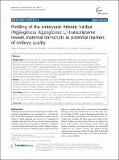Files in this item
Profiling of the embryonic Atlantic halibut (Hippoglossus hippoglossus L.) transcriptome reveals maternal transcripts as potential markers of embryo quality
Item metadata
| dc.contributor.author | Mommens, Maren | |
| dc.contributor.author | Fernandes, Jorge M. O. | |
| dc.contributor.author | Tollefsen, Knut Erik | |
| dc.contributor.author | Johnston, Ian A. | |
| dc.contributor.author | Babiak, Igor | |
| dc.date.accessioned | 2014-11-19T10:31:03Z | |
| dc.date.available | 2014-11-19T10:31:03Z | |
| dc.date.issued | 2014-09-30 | |
| dc.identifier | 157829460 | |
| dc.identifier | 93bccbb1-1561-4562-98f4-4b48351f614d | |
| dc.identifier | 000343176700001 | |
| dc.identifier | 84930812710 | |
| dc.identifier | 000343176700001 | |
| dc.identifier.citation | Mommens , M , Fernandes , J M O , Tollefsen , K E , Johnston , I A & Babiak , I 2014 , ' Profiling of the embryonic Atlantic halibut (Hippoglossus hippoglossus L.) transcriptome reveals maternal transcripts as potential markers of embryo quality ' , BMC Genomics , vol. 15 , 829 . https://doi.org/10.1186/1471-2164-15-829 | en |
| dc.identifier.issn | 1471-2164 | |
| dc.identifier.other | ORCID: /0000-0002-7796-5754/work/47136023 | |
| dc.identifier.uri | https://hdl.handle.net/10023/5795 | |
| dc.description | This study was funded by the Research Council of Norway (Project nr. 182653/V10) and the NIVA SIS project “MolPOP”. | en |
| dc.description.abstract | Background: Commercial Atlantic halibut (Hippoglossus hippoglossus) farming is restricted by variable oocyte quality, slow growth, and early maturation of male fish. Maternally transferred components regulate early developmental processes; therefore, they have an effect on the future viability of the embryo. Using a newly developed Agilent 10 k custom-made oligonucleotide array, we profiled components of the transcriptome involved in immune defence as well as germline and muscle development during early developmental stages: 8-cell embryos (8CS), germ ring stage (GR), 10-somite stage (10SS), and hatched embryos (HT). In addition, we identified differentially expressed transcripts in low (= 86 +/- 3 degrees% hatching) quality eggs at 8CS to identify potential maternal markers for embryo quality. Results: Out of 2066 differentially expressed transcripts, 160 were identified as maternal transcripts being specifically expressed at 8CS only. Twenty transcripts were differentially expressed in 8-cell embryos between low and high quality egg groups. Several immune-related transcripts were identified as promising molecular markers of hatching success including interferon regulatory factor 7 and mhc class 2A chain. Differential expression was positively validated with quantitative real-time PCR. Conclusions: We have demonstrated maternal transfer of innate and adaptive immune system transcripts into Atlantic halibut embryos and their relation with future embryo developmental potential. We identified several transcripts as potential molecular markers of embryo quality. The developed microarray represents a useful resource for improving the commercial production of Atlantic halibut. | |
| dc.format.extent | 13 | |
| dc.format.extent | 1426468 | |
| dc.language.iso | eng | |
| dc.relation.ispartof | BMC Genomics | en |
| dc.subject | Atlantic halibut | en |
| dc.subject | Egg quality | en |
| dc.subject | Embryonic development | en |
| dc.subject | Maternal transcripts | en |
| dc.subject | Microarray | en |
| dc.subject | Transcriptome | en |
| dc.subject | Trout oncorhynchus-mykiss | en |
| dc.subject | Messenger-RNA stockpile | en |
| dc.subject | Primordial germ-cells | en |
| dc.subject | Developmental competence | en |
| dc.subject | Gene-expression | en |
| dc.subject | Flesh quality | en |
| dc.subject | Dead-end | en |
| dc.subject | Zebrafish | en |
| dc.subject | Migration | en |
| dc.subject | QH301 Biology | en |
| dc.subject.lcc | QH301 | en |
| dc.title | Profiling of the embryonic Atlantic halibut (Hippoglossus hippoglossus L.) transcriptome reveals maternal transcripts as potential markers of embryo quality | en |
| dc.type | Journal article | en |
| dc.contributor.institution | University of St Andrews. School of Biology | en |
| dc.contributor.institution | University of St Andrews. Marine Alliance for Science & Technology Scotland | en |
| dc.contributor.institution | University of St Andrews. Scottish Oceans Institute | en |
| dc.contributor.institution | University of St Andrews. Centre for Research into Ecological & Environmental Modelling | en |
| dc.identifier.doi | 10.1186/1471-2164-15-829 | |
| dc.description.status | Peer reviewed | en |
| dc.identifier.url | http://www.biomedcentral.com/1471-2164/15/829/additional | en |
This item appears in the following Collection(s)
Items in the St Andrews Research Repository are protected by copyright, with all rights reserved, unless otherwise indicated.

